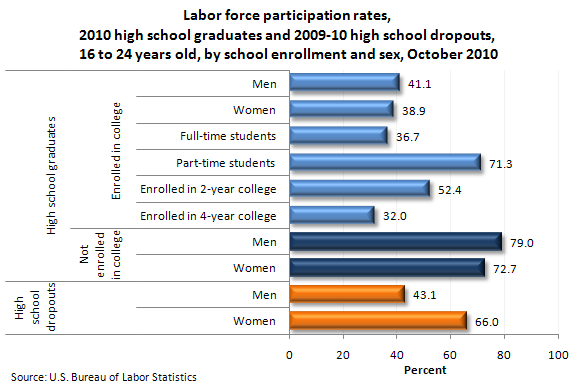April 12, 2011 (The Editor’s Desk is updated each business day.)
High school grads not enrolled in college more likely to be in the labor force
In October 2010, recent high school graduates not enrolled in college were more likely than enrolled graduates to be working or looking for work (76.6 percent compared with 40.0 percent).

[Chart data]
In October 2010, the labor force participation rates (the proportion of the population working or looking for work) for male and female high school graduates enrolled in college were about the same (41.1 and 38.9 percent, respectively).
Recent high school graduates enrolled as full-time students in October 2010 were about half as likely to be in the labor force (36.7 percent) as those enrolled as part-time students (71.3 percent).
Among recent high school graduates who were enrolled in 4-year colleges in October 2010, 32.0 percent participated in the labor force, compared with 52.4 percent of recent graduates enrolled in 2-year colleges.
In October 2010, the labor force participation rate for recent high school dropouts (53.9 percent) was lower than for recent high school graduates not enrolled in college (76.6 percent).
This information is from a supplement to the October 2010 Current Population Survey (CPS), a monthly nationwide survey of about 60,000 households that provides basic data on national employment and unemployment. Additional information is available from "College Enrollment and Work Activity of 2010 High School Graduates" (HTML) (PDF) news release USDL-11-0462.
Related TED articles
Education and training |
Employment |
Men |
Women |
Youth
Of interest
Spotlight on Statistics: National Hispanic Heritage Month
In this Spotlight, we take a look at the Hispanic labor force—including labor force participation, employment and unemployment, educational attainment, geographic location, country of birth, earnings, consumer expenditures, time use, workplace injuries, and employment projections.
.
Read more »
